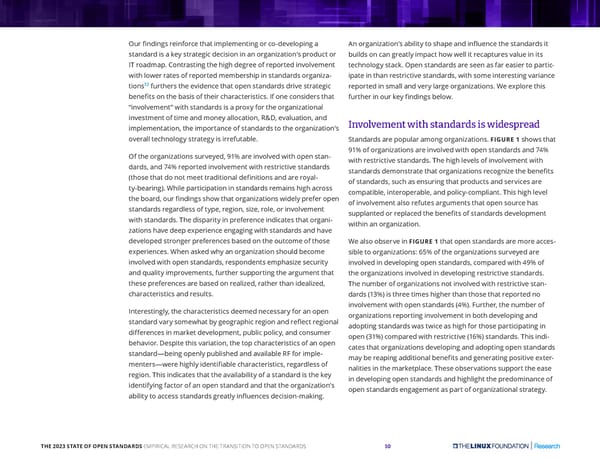Our findings reinforce that implementing or co-developing a An organization’s ability to shape and influence the standards it standard is a key strategic decision in an organization’s product or builds on can greatly impact how well it recaptures value in its IT roadmap. Contrasting the high degree of reported involvement technology stack. Open standards are seen as far easier to partic- with lower rates of reported membership in standards organiza- ipate in than restrictive standards, with some interesting variance 12 furthers the evidence that open standards drive strategic tions reported in small and very large organizations. We explore this benefits on the basis of their characteristics. If one considers that further in our key findings below. “involvement” with standards is a proxy for the organizational investment of time and money allocation, R&D, evaluation, and Involvement with standards is widespread implementation, the importance of standards to the organization’s overall technology strategy is irrefutable. Standards are popular among organizations. FIGURE 1 shows that Of the organizations surveyed, 91% are involved with open stan- 91% of organizations are involved with open standards and 74% dards, and 74% reported involvement with restrictive standards with restrictive standards. The high levels of involvement with (those that do not meet traditional definitions and are royal- standards demonstrate that organizations recognize the benefits ty-bearing). While participation in standards remains high across of standards, such as ensuring that products and services are the board, our findings show that organizations widely prefer open compatible, interoperable, and policy-compliant. This high level standards regardless of type, region, size, role, or involvement of involvement also refutes arguments that open source has with standards. The disparity in preference indicates that organi- supplanted or replaced the benefits of standards development zations have deep experience engaging with standards and have within an organization. developed stronger preferences based on the outcome of those FIGURE 1 that open standards are more acces- We also observe in experiences. When asked why an organization should become sible to organizations: 65% of the organizations surveyed are involved with open standards, respondents emphasize security involved in developing open standards, compared with 49% of and quality improvements, further supporting the argument that the organizations involved in developing restrictive standards. these preferences are based on realized, rather than idealized, The number of organizations not involved with restrictive stan- characteristics and results. dards (13%) is three times higher than those that reported no Interestingly, the characteristics deemed necessary for an open involvement with open standards (4%). Further, the number of standard vary somewhat by geographic region and reflect regional organizations reporting involvement in both developing and differences in market development, public policy, and consumer adopting standards was twice as high for those participating in behavior. Despite this variation, the top characteristics of an open open (31%) compared with restrictive (16%) standards. This indi- standard—being openly published and available RF for imple- cates that organizations developing and adopting open standards menters—were highly identifiable characteristics, regardless of may be reaping additional benefits and generating positive exter- region. This indicates that the availability of a standard is the key nalities in the marketplace. These observations support the ease identifying factor of an open standard and that the organization’s in developing open standards and highlight the predominance of ability to access standards greatly influences decision-making. open standards engagement as part of organizational strategy. THE 2023 STATE OF OPEN STANDARDS EMPIRICAL RESEARCH ON THE TRANSITION TO OPEN STANDARDS 10
 The 2023 State of Open Standards Page 9 Page 11
The 2023 State of Open Standards Page 9 Page 11